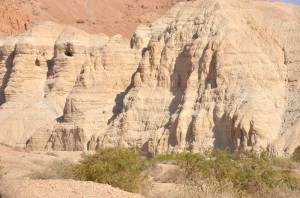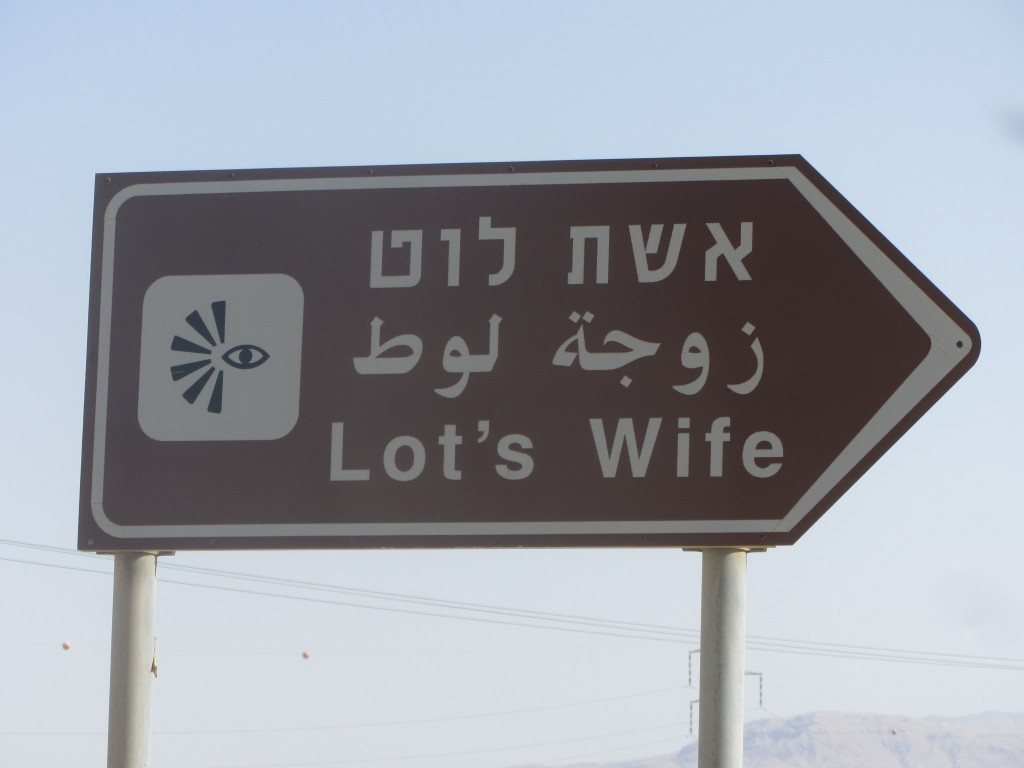The Dead Sea region is in Jerusalem’s backyard. Within a half hour of passing out of Jerusalem and into the Judean Desert we have descended 1200 meters (4,000′) to the lowest place on Earth, the Dead Sea. The Sea is fed by the lower Jordan River and it was not far from here that the Children of Israel crossed the dry river bed into the Holy Land.
We experience the sudden transition from green Jerusalem to the Judean Desert, the smallest desert in the world. Due to its quiet and proximity to the Holy City, it became, during Byzantine times a popular place for monks to live out one of the ideals of Christian life. Today we can see the remains of some of those places in the largest Jewish town in Judea, Maaleh Adumim. This community continues to expand, a bedroom community of Jerusalem, whose industrial area was home to a Soda Stream factory where both Palestinian Arabs and Jewish Israelis were employed side by side.
As we descend further the trees become more sparse. Camels, goats and sheep can be spotted by the observant on the ridge lines above the highway and small Bedouin shanty towns appear as well. When we gaze upon the still-life scenes at the Bedouin encampments we should reflect that this is as close as we can come to understanding the life-style of our Biblical patriarchs and matriarchs who lived here close to 4,000 years ago.
A little further on we pass the sign informing us that we are now at Sea Level. Here a lone Beduin waits with his decked-out camel for people like us to pull over for a great photo-op.
As we come around a turn the entire Jordan Valley opens up to us and we see the flat city of Jericho sprawled out on the desert floor a couple of miles to our north on the left. To our right the Dead Sea extends beyond the horizon. Here we will enter Jericho, under full control of the Palestinian Authority. After a while here it truly feels like a different country. The pace is slower and people watch you carefully. We will be visiting the traditional site of the Sycamore Tree where Jesus encounters the tax collector Zacchaeus. Then we’ll head out to see the traditional site of the Mount of Temptation where Jesus was tempted by the devil after his baptism.
Upon our return from Jericho to the main road we turn left and half a minute later we contemplate a quick stop at the next junction which provides gas for travelers, food, some shopping, and another camel ride opportunity.
Continuing down the road for just a few minutes we approach Highway 90, Israel’s longest highway. This part of the highway was built at the beginning of the Oslo Peace process in the 1990’s as a bypass around the city of Jericho when Israel pulled its forces out of that town and gave all authority there over to the newly created Palestinian Authority. At the junction we turn left and north and travel a little while until we come upon the sign for the national park, Qasr El Yahud. It was somewhere in the Jordan River, as described in Matthew 3:13-17, that Jesus came to be baptized by his cousin, John the Baptist as a prelude to his ministry in the Galilee.
Upon departure from the river we turn left, and south again, in the direction of the Dead Sea. At the junction we turn left and stay on Highway 90 and a few minutes later if we are observant we will see a herd of some 40 young camels grazing in the desert under the watchful eyes of their young Bedouin shepherd. We now parallel the Dead Sea on our way south toward Masada.
 Our first stop will be Qumran, site of the discovery of the Dead Sea Scrolls in 1947 by three Bedouin. The Scrolls are said by scholars to be the most important discovery for the understanding of both Christianity and Judaism. The Scrolls contain the oldest surviving copies of the Bible by more than a thousand years, and the text is almost exactly the same as the text that we use today. Most interesting, if one can read modern Hebrew one can read the Dead Sea Scrolls, written 2,100 years ago!
Our first stop will be Qumran, site of the discovery of the Dead Sea Scrolls in 1947 by three Bedouin. The Scrolls are said by scholars to be the most important discovery for the understanding of both Christianity and Judaism. The Scrolls contain the oldest surviving copies of the Bible by more than a thousand years, and the text is almost exactly the same as the text that we use today. Most interesting, if one can read modern Hebrew one can read the Dead Sea Scrolls, written 2,100 years ago!
We continue our journey southwards and in another 30 minutes Masada begins to appear, a mountain set slightly apart from its surroundings and slightly to the east of the cliffs of the Judean Desert. The story of Masada inspired generations of Israelis and despite todays more critical approach to this part of Jewish history the mountain and its stories hold an irresistible attraction.
As we approach the desert fortress it’s features become clearer and we notice the step-like structures on the northern side of the mountain, Herod the Great’s Northern Palace. We also note a serpentine white trail which makes its way up from the desert floor to the gates of Masada, the so-called Snake Path. We will spend between an hour to three hours here at Masada, including the tour upon the summit, the cable car, short movie, extensive gift shop and possibly, lunch.
Still thinking about our last stop we begin the return journey to Jerusalem. Just 15 minutes later we enter the National Park at Ein Gedi. King David escaped King Saul’s wrath here and ultimately an event which took place lead to their reconciliation. Ein Gedi’s fame in the ancient world however stemmed from its secret formula for a perfume with aphrodisiac-like qualities. We’ll use the waters here to refresh ourselves.
We change into bathing suits and prepare for a 20 minute hike up Nahal David, or David’s Canyon. The best water in Israel flows down the canyon, originating in a spring found high above us. Our goal is the high water-fall which marks the end of our trail. On the way down, sweating now, we find a waist-deep pool and gingerly enter the very cold water. Everyone who enters the waters of Ein Gedi comes away refreshed and pleased. We return to the bottom of the trail, always keeping an eye our for the little Hyrax and nimble-footed Ibex that make their homes in this nature reserve.
Refreshed and seeking new experiences we continue north to visit a beach on the Dead Sea itself. Dead Sea water is so dense that everything, including people, float in it. Enter carefully, as anyone with cuts on their bodies will instantly be reminded of their condition when the salt water touches them. Now lie back…and float, without a care in the world. The mountains of Moab across the Sea from us, begin to turn its famous reddish hue as the sun begins to move lower in the sky. We begin to think of dinner and so, reluctantly, depart the lowest place on Earth.
We begin the climb back towards Jerusalem in earnest and just a few minutes before entering the city, we turn off the main road and find ourselves in a desert encampment called Genesis Land (Eretz Beresheet). Here we’ll have a short camel ride and enter an open tent where an appropriately garbed character will recall for us the story of the Patriarchs from Genesis in the first parts of the Bible. Here the food keeps on coming and no one needs a midnight snack after this desert feast. We finally make our way back to Jerusalem as the sun sets. We will not forget this day.

